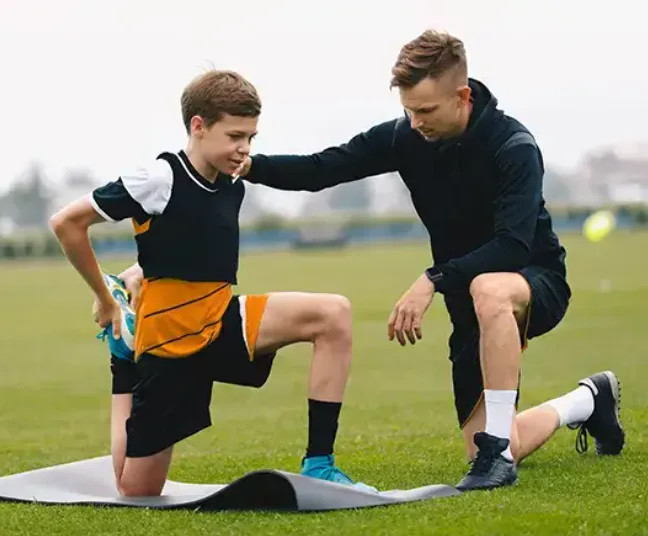As a busy parent, it’s easy to get overwhelmed by juggling work, family obligations, and extracurricular activities. Between soccer practice, piano lessons, and homework, finding time to help your child grow and stay excited about their passions can feel like a challenge. But here’s one simple solution that has made a huge difference for my family: in-home soccer training.
It’s practical, effective, and honestly, it’s helped my child improve at a faster pace than I ever anticipated. If you’re wondering whether in-home training is worth the time and effort, let me share why I believe it’s the future of youth soccer development and how you can make it work—even with a busy schedule and limited space.
The Mental Benefits of Soccer Training at Home
One of the most surprising lessons I’ve learned is that soccer doesn’t just improve a child’s physical abilities—it boosts brain function too. When kids repeatedly perform skills like dribbling or toe taps, they’re not only improving their physical coordination but also strengthening cognitive skills such as memory, decision-making, and focus.
Studies show that short, focused practices in a calm environment, such as your garage or driveway, are often more effective than chaotic team practices where kids only get limited touches on the ball. It’s a simple but powerful way to help them process decisions and refine their skills.
Why We Chose In-Home Training and Haven’t Looked Back
For us, in-home soccer training made a world of difference for several reasons:
Fits Our Busy Schedule
No commute, no weather concerns—my child can train whenever it’s convenient. Whether before school, after dinner, or even during a break from homework, it’s incredibly flexible.Affordable and Accessible
You don’t need expensive equipment or a professional field to get started. We began with just a ball, some cones, and a small space in the garage.Boosted My Child’s Confidence
Before we started home drills, my child was often hesitant during games. After just a few weeks of consistent practice, they became more confident on the field and even started scoring goals!Strengthened Our Bond
We’ve turned training into a fun family routine. Sometimes I’m involved in passing drills, and other times I just watch. Either way, it’s become a special time for us.
Essential In-Home Equipment (You Don’t Need Much)
Starting with the basics is key. Here’s the simple equipment we use regularly:
Soccer Ball (Size 4 or 5, depending on age)
Cones (We even use plastic cups when we can’t find our cones!)
Pop-up Goal or Wall Target for shooting practice
Agility Ladder for footwork drills
Soccer Rebounder for improving first touch
Bluetooth Speaker (We use it to play instructional videos and music during training)
If you’re on a tight budget, socks can substitute for cones, and a garage door can act as your goal. It doesn’t have to be complicated to start seeing results.
Taking Training to the Next Level
If you’re ready to step it up, consider investing in an interactive rebounder like the A-Champs Rebounder. It’s more than just a rebound board—equipped with lights and sensors, it challenges your child’s reaction time and decision-making, making training feel more like real game situations. I’m planning to get one for my son to help him sharpen his skills as a midfielder, where quick decision-making and first touch are crucial.
Free Soccer Skills Challenge to Get You Started
If you’re unsure where to begin, I recommend trying a free 7-day soccer skills challenge. This is how we got started, and it’s still a core part of our routine. It’s designed for parents with no coaching experience, featuring:
Daily 15-minute drills (easy to follow)
A mix of dribbling, passing, and agility exercises
A progress tracker to see improvements
It’s simple, fun, and perfect for fitting into your busy day. You can download the 7-day challenge and get started right away.
Real Results: What We’ve Noticed Since Starting
Since we began in-home training, I’ve noticed several positive changes:
Improved First Touch: My child’s control over the ball has become much more consistent.
Confidence on the Field: They’re no longer hesitant; they step up and take risks.
Enjoyment of Solo Practice: Without the pressure of teammates or competition, they’ve grown to love practicing on their own.
Stronger Connection: As a parent, I’m no longer just the one driving them to practice. I’m actively involved in their development, and it’s been an enriching experience for both of us.
In fact, after just one week of short, focused home practices, I noticed more growth than in an entire month of regular team training.
Final Thoughts: In-Home Training is the Future of Soccer
In-home soccer training isn’t a replacement for team practices, but it’s a valuable addition. Just 10-15 minutes of focused work at home can make a huge difference in your child’s development. The key is consistency, engagement, and making it fun.
You don’t need to be a coach to help your child improve—sometimes, all you need is to be a supportive presence. So, if you’ve been feeling overwhelmed or unsure of how to help your child get better, I encourage you to give in-home training a try. You might just see a huge shift in their skills and confidence—and it might all start right in your living room.
















